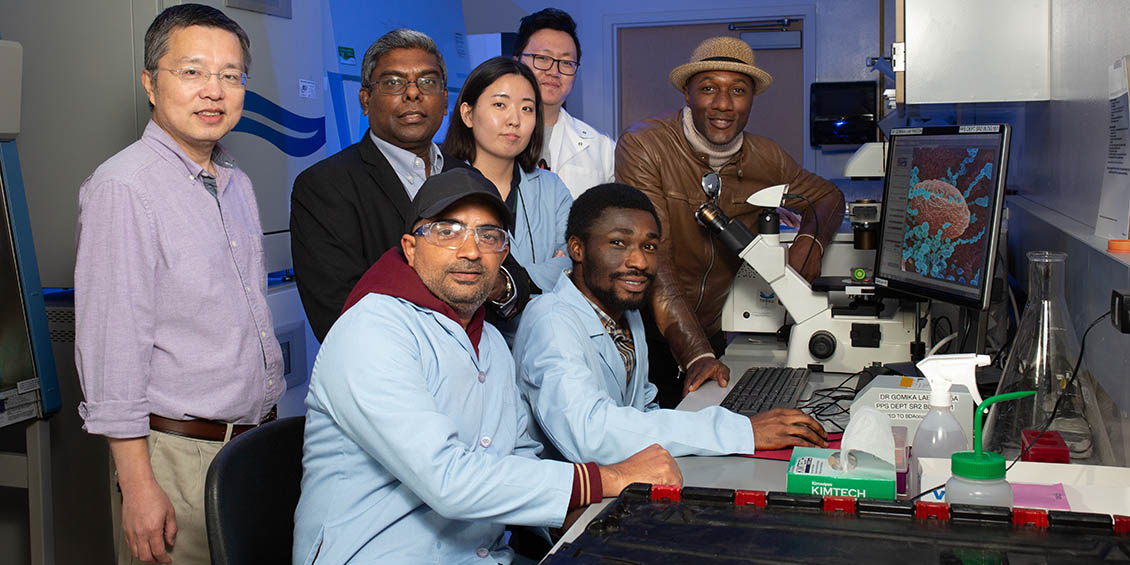Research News

Pitch Perfect Prevention
Grammy-nominated Recording Artist Aloe Blacc Aims to Bring Down House on COVID Infection Backing Drug Development by UHCOP Researchers
January 9 — What do you get when you cross an inquisitive Grammy-nominated recording artist, a medicinal chemist and biology expert? A potential blockbuster hit in the future prevention of not only coronavirus/SARS-related viral infections, but also autoimmune diseases, cancer and a range of other clinical applications.
How this unlikely trio – Aloe Blacc, whose hit song "Wake Me Up" topped the charts, and University of Houston College of Pharmacy faculty researchers Gomika Udugamasooriya, Ph.D., and Bin Guo, Ph.D. – formed owes much to the very thing the three are working to prevent, if not eradicate: COVID-19 infection.
Initially intrigued by the idea of developing breathalyzer-type devices for detecting COVID, Blacc said he immersed himself in the biochemistry of prevention after contracting the disease in January 2022 in spite of being fully vaccinated and boosted.
"My COVID symptoms were relatively mild, so I was grateful, but I had lost a couple of friends and I felt deeply for those who really suffered," Blacc said. "I wondered if it was possible to block viral transmission rather than just enhancing our immune system. Could we block it in the same way that antihistamines block allergens?"
"Chasing"
After learning how the coronavirus spike protein binds to the angiotensin-converting enzyme 2 (ACE2) receptor, Blacc took to the web and turned up an August 2021 paper by Udugamasooriya and Guo on "'Molecular Masks' for ACE2 to Effectively and Safely Block SARS-CoV-2 Virus Entry." He then reached out to the investigators – who admit they initially thought they were being "catfished" – to learn more about the technology and the drug discovery and development process as a whole.
"By far, it was their research that stood out as the most promising solution," Blacc said. "I was reading all the research papers on COVID and ACE2, and it seemed that others were concerned with how to target and disarm the virus. I felt strongly that blocking binding at ACE2 was more efficient than chasing moving targets."
The technology centers on the unique on-bead two-color (OBTC) cell screening process developed over several years by Udugamasooriya to identify compounds with high receptor-binding selectivity at a much lower cost and infrastructure investment than conventional drug discovery methods.
Among the many challenges, most important is identifying compounds that can prevent infection via the ACE2 receptors without interfering with ACE2 receptor expression and function, which is a critical molecular pathway for the cardiovascular system, including metabolism and blood pressure.
"Green Lights," Red Dyes
Udugamasooriya’s approach is exquisitely simple: Take a cell type lacking the receptor of interest, stain it with a green dye, then add the receptor of interest to another group of the same cells, but stained with a red dye.
After mixing the two red and green cell groups, the cell mixtures are exposed to beads that display peptoid library compounds. Each bead has a single compound with lot of copies. Different beads have different compounds and the library has tens of thousands of beads (compounds).
Beads bound with only red cells on its surface indicate high selectivity to the receptor, whereas beads with red and green-dyed cells have poor selectivity of the receptor and are discarded.
Applying the technique to the ACE2 receptor, Udugamasooriya and Guo have identified at least two compounds with high selectively to the specific ACE2 receptor domain, meaning cell entry by the virus is blocked without affecting the receptor’s expression, stability or function.
"We think about the SARS-CoV-2 viruses using its spike protein as the key to open the door to the human cell; our compounds block the doorknob – or, said another way, it’s a molecular version of a face mask," Udugamasooriya said. "Although the pandemic seems to have waned in recent months, it’s inevitable that we will continue to face new variants – as well as completely new SARS-related or SARS-like viruses – for some time in the future, despite vaccination programs. Our compounds do not get outdated as vaccines do with virus mutations."
"Getting Started"
The identified compounds have been filed with the U.S. Patent Office, one of eight such patents Udugamasooriya has filed based on his OBTC system. While Udugamasooriya’s OBTC process itself is an inexpensive technology, moving the selected compounds through the next phases of FDA requirements – including additional pre-clinical toxicity studies and human clinical trials – is another matter. To that end, Blacc backed the in-vivo studies in a small mammal model of infection.
"The preliminary in-vivo study results have not been published, but we confirmed the compounds were not toxic and produced lung protection vs. the control group after challenged with the virus," Guo said.
To help move forward the additional studies required for FDA approval, Blacc established a start-up company named in honor of his retired U.S. Marine Corps father – Major Inc., LLC – with license to the compound.
"Doing the impossible by finding major solutions to major problems is why I've established this company, and my father has always pushed me to achieve my greatest goals," Blacc said. "It's difficult to express how hopeful I am about this solution to the pandemic. I'm optimistic that we have an opportunity to transform the future of medicine and our relationship to viruses."
